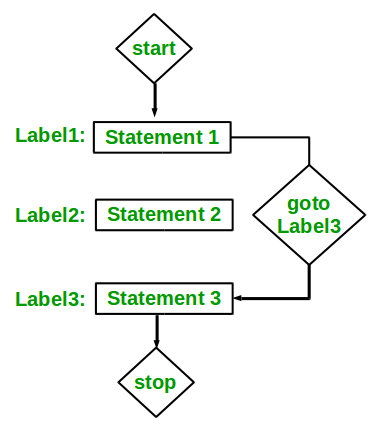The goto statement in C allows the program to jump to some part of the code, giving you more control over its execution. While it can be useful in certain situations, like error handling or exiting complex loops, it's generally not recommended because it can make the code harder to read and maintain.
Let's take a look at an example:
C #include <stdio.h> int main() { int n = 0; // If the number is zero, jump to // jump_here label if (n == 0) goto jump_here; // This will be skipped printf("You entered: %d\n", n); jump_here: printf("Exiting the program.\n"); return 0; } OutputExiting the program.
Explanation: In this program, a predefined value is assigned to num. If n equals 0, the program jumps to the jump_here label using the goto statement. If n is non-zero, the program prints the value. The goto statement is used to control the flow by jumping to a specific part of the program.
Syntax
Syntax1 | Syntax2
----------------------------
goto label; | label:
. | .
. | .
. | .
label: | goto label;
In the above syntax, the first line tells the compiler to go to or jump to the statement marked as a label. Here, the label is a user-defined identifier that indicates the target statement. The statement immediately followed after 'label:' is the destination statement. The 'label:' can also appear before the 'goto label;' statement in the above syntax.
Flowchart of goto
 Flowchart of goto Statement in C
Flowchart of goto Statement in CThe goto statement allows for jumping to specific parts of a program and understanding its function is still valuable.
Examples of goto
Below are some examples of how to use a goto statement.
Check Even or Odd Number
C #include <stdio.h> int main() { int n = 26; if (n % 2 == 0) // jump to even goto even; else // Jump to odd goto odd; even: printf("%d is even", n); return 0; odd: printf("%d is odd", n); return 0; } Prints numbers from 1 to 10
C #include <stdio.h> int main(){ int n = 1; // Label here label: printf("%d ", n); n++; if (n <= 10) // jumb back to the label goto label; return 0; } Output1 2 3 4 5 6 7 8 9 10
Explanation: The goto statement is used in this program to print numbers from 1 to 10. The variable n is incremented, and the program jumps back to the label to print the next number until n exceeds 10.
Jumping Out of a Nested Loop
C #include <stdio.h> int main() { int i, j; for (i = 0; i < 5; i++) { for (j = 0; j < 5; j++) { if (i == 2 && j == 2) { // Break out of both loops goto exit_loops; } printf("%d %d\n", i, j); } } exit_loops: printf("Exited loop"); return 0; } Output0 0 0 1 0 2 0 3 0 4 1 0 1 1 1 2 1 3 1 4 2 0 2 1 Exited loop
Explanation: In this example, goto is used to exit both the inner and outer loops when i == 2 and j == 2. Without goto, we would have to use flags or multiple break statements, which would be more complicated.
Error Handling Using goto
C #include <stdio.h> int main() { int num = -1; // Check if num is -1 if (num == -1) { // Jump to error handling goto error; } printf("Valid input: %d\n", num); return 0; error: printf("Error: Invalid input detected.\n"); return -1; } OutputError: Invalid input detected.
Explanation: goto is used to jump to the error label when an invalid input (e.g., -1) is entered. This allows for centralized error handling.
Conclusion
In conclusion, the goto statement in C provides a way to jump to a specific point in the program, offering a method for controlling the flow of execution. While it can simplify certain tasks, such as error handling or managing complex loops, excessive use of goto can lead to poor code readability and maintainability. It's often recommended to use structured control flow statements like for, while, and if in place of goto for cleaner and more understandable code.
Explore
C Basics
Arrays & Strings
Pointers and Structures
Memory Management
File & Error Handling
Advanced Concepts
My Profile